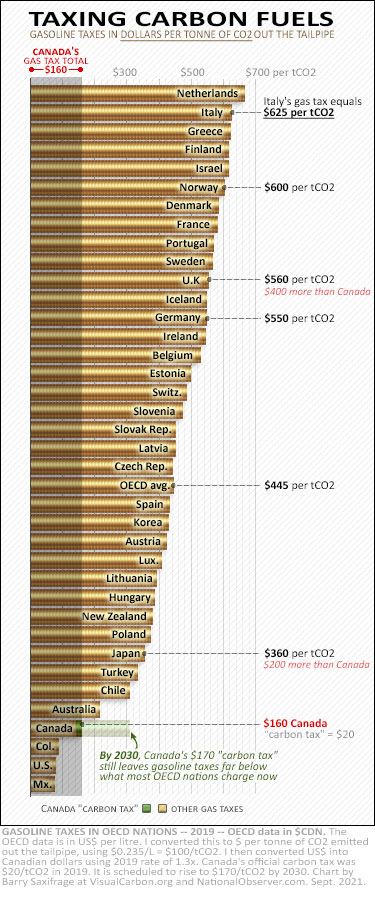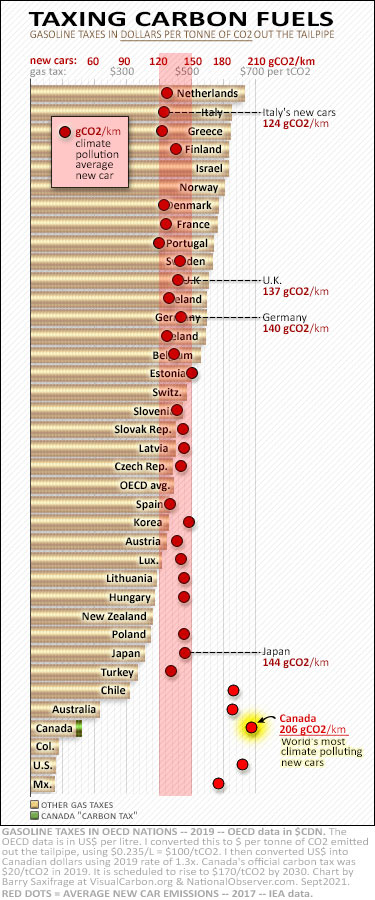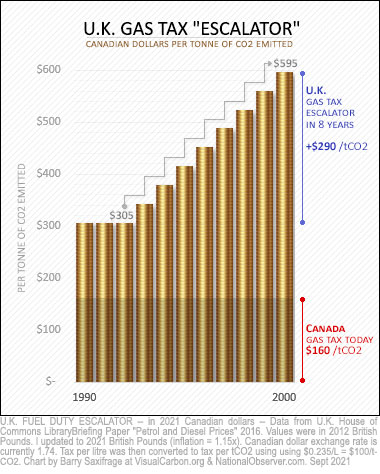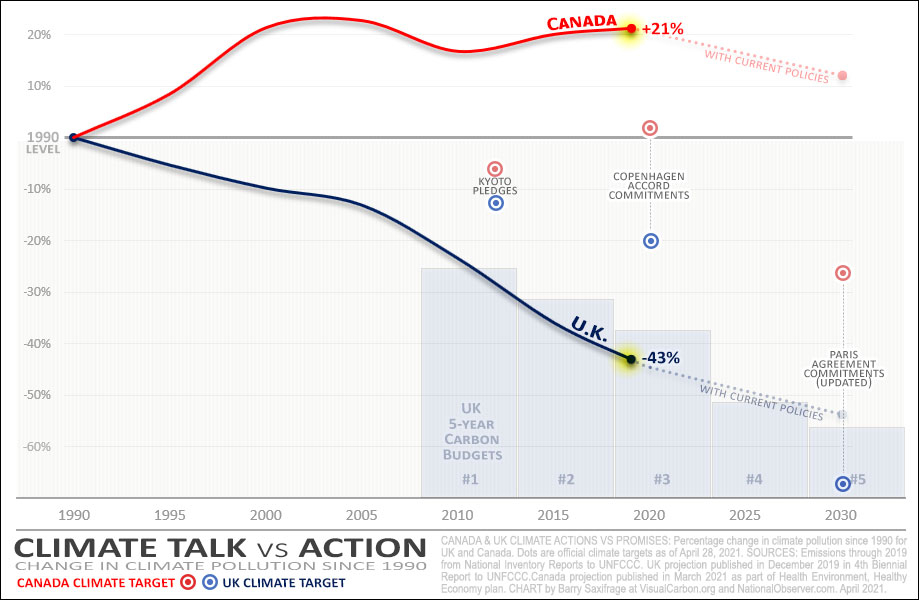
Pricing carbon: Canada’s ‘carbon tax’ versus international gas taxes
By Barry Saxifrage | Analysis | October 1st 2021
#1756 of 1757 articles from the Special Report:
NATIONAL OBSERVER
When I was a kid, oil companies gave away trinkets with each fill-up, like collectible drinking glasses and fake tiger tails. Now we get bigger things — like 1,000-year heat waves, superstorms, megafires, and crop failures.
In fact, Canadians filling up at the pump have been a primary driver behind our nation's 30 years of climate failure. As my first chart below shows, Canadian tailpipe emissions have been surging relentlessly upwards since 1990.
The dashed line shows the climate pollution from gasoline and diesel purchased at the pump, for both passenger and freight vehicles. This makes up the lion's share of Canada's transport sector emissions, which also includes domestic aviation, rail, and shipping. And these pump sales are what have been driving the huge surge in this sector's emissions.
Back in 1990, the gasoline and diesel we bought at the pump created the same amount of climate pollution as our nation's electricity generation — nearly a hundred million tonnes of CO2 (MtCO2) per year.
Since then, Canadians have made a big push to close coal-fired power plants. As a result, our electricity sector now emits 30 MtCO2 less per year than in 1990.
But all that climate progress was more than wiped out by a 60 MtCO2 surge in the climate pollution we dump out our tailpipes.
That's roughly the same pollution increase as from Canada's oilsands industry — whose emissions jumped by 68 MtCO2 over these same years. Combined, the increased emissions from the oilsands and our pump sales equal all of Canada's 128 MtCO2 jumps in climate pollution since 1990.
In total, pump sales now cause 154 MtCO2 per year. If you include the additional “upstream” emissions from extracting and refining all that gasoline and diesel, the full climate impact reaches 190 MtCO2. On the chart, those additional emissions are included in the oil & gas sector line.
To put the climate pollution from our gasoline and diesel-burning into an international context, there are 150 nations whose entire economies emit less.
Why is our pump-and-dump so out of control in Canada? And what have other nations done to rein theirs in?
Putting a price on carbon
The primary tool nations use to rein in profligate gasoline burning is the gas tax. Gas taxes raise the price at the pump. Higher prices create greater incentives to use gasoline more efficiently. And higher prices also make the less-toxic and less climate-damaging alternatives — like transit, cycling, and electric vehicles — more attractive and cost-competitive.
Analysis: Maybe charging a bit closer to what these other nations do to pump-it-and-dump-it would finally get us headed in the right direction on the road to a safe and sane climate future, writes columnist @bsaxifrage. #CarbonTax #GasTax #emissions
Nations differ widely in the amount they tax gasoline. Canada, even with our much-ballyhooed “carbon tax,” is one of the laggards. Take a look.

This next chart shows gasoline taxes for Canada and many of its peers. The data comes from the Organization for Economic Co-operation and Development (OECD).
I've converted the tax per litre to the equivalent “carbon tax” per tonne of CO2 (tCO2) emitted. (Math note: $0.10/L = $43/tCO2 emitted.)
As you can see, nations like Italy, Norway, Britain, and Germany tax their gasoline at least $550 per tCO2. That's $400 more per tCO2 than Canada levies.
What does Canada charge? You need to look way down at the bottom to see that Canada taxes gasoline at just $160 per tCO2.
Notice, also, that our official “carbon tax” (the dark green part of the bar) is tiny compared to the de facto carbon tax imposed by Canada and other nations via other taxes on gasoline. Focusing just on our small official “carbon tax” can distract from the big picture — how high Canada and other nations are setting the effective carbon price on gasoline via all taxes combined.
By 2030, Canada says it will raise our official “carbon tax” up to $170 per tCO2. You can see what that will do by looking at the pale green part of Canada's bar on the chart.
We'll still be charging much less for our tailpipe emissions — in 2030 — than nearly every other OECD nation charges today.
Cheaper carbon = super-polluting cars
As we've seen, Canada's low carbon price for gasoline has greenlighted our surging emissions and decades of climate failure. And there's another threat it has been unleashing — locking in large amounts of future climate pollution and financial risk.
My next chart shows why.
When I was a kid, oil companies gave away trinkets with each fill-up, like collectible drinking glasses and fake tiger tails. Now we get bigger things — like 1,000-year heat waves, superstorms, megafires, and crop failures.
In fact, Canadians filling up at the pump have been a primary driver behind our nation's 30 years of climate failure. As my first chart below shows, Canadian tailpipe emissions have been surging relentlessly upwards since 1990.
The dashed line shows the climate pollution from gasoline and diesel purchased at the pump, for both passenger and freight vehicles. This makes up the lion's share of Canada's transport sector emissions, which also includes domestic aviation, rail, and shipping. And these pump sales are what have been driving the huge surge in this sector's emissions.
Back in 1990, the gasoline and diesel we bought at the pump created the same amount of climate pollution as our nation's electricity generation — nearly a hundred million tonnes of CO2 (MtCO2) per year.
Since then, Canadians have made a big push to close coal-fired power plants. As a result, our electricity sector now emits 30 MtCO2 less per year than in 1990.
But all that climate progress was more than wiped out by a 60 MtCO2 surge in the climate pollution we dump out our tailpipes.
That's roughly the same pollution increase as from Canada's oilsands industry — whose emissions jumped by 68 MtCO2 over these same years. Combined, the increased emissions from the oilsands and our pump sales equal all of Canada's 128 MtCO2 jumps in climate pollution since 1990.
In total, pump sales now cause 154 MtCO2 per year. If you include the additional “upstream” emissions from extracting and refining all that gasoline and diesel, the full climate impact reaches 190 MtCO2. On the chart, those additional emissions are included in the oil & gas sector line.
To put the climate pollution from our gasoline and diesel-burning into an international context, there are 150 nations whose entire economies emit less.
Why is our pump-and-dump so out of control in Canada? And what have other nations done to rein theirs in?
Putting a price on carbon
The primary tool nations use to rein in profligate gasoline burning is the gas tax. Gas taxes raise the price at the pump. Higher prices create greater incentives to use gasoline more efficiently. And higher prices also make the less-toxic and less climate-damaging alternatives — like transit, cycling, and electric vehicles — more attractive and cost-competitive.
Analysis: Maybe charging a bit closer to what these other nations do to pump-it-and-dump-it would finally get us headed in the right direction on the road to a safe and sane climate future, writes columnist @bsaxifrage. #CarbonTax #GasTax #emissions
Nations differ widely in the amount they tax gasoline. Canada, even with our much-ballyhooed “carbon tax,” is one of the laggards. Take a look.

This next chart shows gasoline taxes for Canada and many of its peers. The data comes from the Organization for Economic Co-operation and Development (OECD).
I've converted the tax per litre to the equivalent “carbon tax” per tonne of CO2 (tCO2) emitted. (Math note: $0.10/L = $43/tCO2 emitted.)
As you can see, nations like Italy, Norway, Britain, and Germany tax their gasoline at least $550 per tCO2. That's $400 more per tCO2 than Canada levies.
What does Canada charge? You need to look way down at the bottom to see that Canada taxes gasoline at just $160 per tCO2.
Notice, also, that our official “carbon tax” (the dark green part of the bar) is tiny compared to the de facto carbon tax imposed by Canada and other nations via other taxes on gasoline. Focusing just on our small official “carbon tax” can distract from the big picture — how high Canada and other nations are setting the effective carbon price on gasoline via all taxes combined.
By 2030, Canada says it will raise our official “carbon tax” up to $170 per tCO2. You can see what that will do by looking at the pale green part of Canada's bar on the chart.
We'll still be charging much less for our tailpipe emissions — in 2030 — than nearly every other OECD nation charges today.
Cheaper carbon = super-polluting cars
As we've seen, Canada's low carbon price for gasoline has greenlighted our surging emissions and decades of climate failure. And there's another threat it has been unleashing — locking in large amounts of future climate pollution and financial risk.
My next chart shows why.

I've added big red dots to show how climate-polluting the average new car is in each nation.
This data comes from the International Energy Agency (IEA). It's in grams of CO2 emitted per kilometre (gCO2/km).
Unsurprisingly, nations that make it more expensive to dump climate pollution out the tailpipe have fewer climate-damaging cars. Like the U.K. and Germany, where new cars average around 140 gCO2/km.
And the flip side is that nations with smaller taxes on gasoline have the most climate-damaging new cars. Like in Canada, Australia, and the U.S., where new cars average over 180 gCO2/km.
In fact, the IEA says Canadians buy the world's most climate-polluting new passenger vehicles. Each one emits 206 gCO2 per kilometre, on average.
This means that Canadians are choosing to burn 50 per cent more gasoline every kilometre — and thus emit 50 per cent more climate pollution — than the British and Germans.
And all our new cars and trucks will still be on the road for another decade or more.
This is what locking in climate failure looks like.
By keeping the price to climate pollute so far below what most OECD and G7 nations charge, we've filled our roads and driveways with the world's most gas-guzzling, hyper-emitting fleet of vehicles. And millions of these will still be there well past 2030, still super-polluting with every kilometre driven.
In addition to locking in excess climate pollution, they also lock in significantly greater financial risk for Canadians who own them. The looming financial risk is that the cost to fill up these highest-emitting-in-the-world vehicles will skyrocket if humanity acts to save itself from the rapidly metastasizing climate crisis.
While Canada chose to keep the cost to climate pollute with our vehicles low, the British took the opposite approach.
The U.K.’s gas tax climate policy
Back in the 1990s, the U.K. introduced a “Fuel Duty Escalator” that raised its gas tax by 39 pence per litre over eight years. (Currency note: The rise was 28 pence at the time, which is equal to 39 pence in today's prices. Dollar prices discussed below are in current Canadian dollars.)

As my next chart shows, the total increase equalled $290 per tCO2 emitted — an additional $36 every year.
Compare that to Canada's official “carbon tax” that is currently raising our gas tax by just $5 per year — seven times slower than the U.K.
Why did the British raise their gas tax so quickly?
The Fuel Duty Escalator was introduced in 1993 by the Conservative government of John Major. Its stated goal was to reduce the nation's climate pollution: “The largest contribution to the growth in United Kingdom carbon dioxide emissions in the coming years is expected to come from the transport sector … (this escalator will) provide a strong incentive for motorists to buy more fuel-efficient vehicles.”
Then in 1997, when a Labour government won, the policy continued. The explanation: “The tax system sends critical signals about the economic activities that a society wishes to promote and deter ... Road traffic is the fastest-growing source of carbon dioxide and the increased commitment will therefore provide a significant contribution to meeting the government’s target for a 20 per cent reduction in emissions of carbon dioxide by the year 2010.”
I want to pause here to highlight that the U.K. did this three decades ago. The climate science was clear enough back then, but the brutal climate impacts occurring now hadn't arrived yet. Now they have. Yet Canada is still dragging its feet on taxing our tailpipe pollution.
So, did the U.K.'s transportation emissions go down?
Yes. Climate pollution from cars and trucks in the U.K. stopped rising in the early 2000s and has since fallen. It's now down to just below 1990 levels. That's obviously a lot better result than in Canada, where our tailpipe emissions soared 50 per cent higher and are still rising.
In addition, the U.K.'s higher carbon price on gasoline has resulted in new passenger cars and trucks there emitting a third less climate pollution every kilometre than ours do in Canada. So, the U.K. has locked in fewer future climate emissions and less gasoline dependency/risk than we have.
Along the way, the U.K. also reduced all its national emissions by 43 per cent. And it managed to meet all its climate targets. Canada … not so much.

Climate pollution changes versus climate targets in Canada and the U.K. from 1990 to 2019.
In Canada, we've allowed our national emissions to rise by 21 per cent — the worst, by far, among the G7 nations. And we've wildly overshot all our climate targets, as well.
What if…
Hey, I know this sounds crazy, but what if Canada did exactly the same thing that our Commonwealth peers did — raise our gas tax by $290 per tCO2 over the next eight years?
It would then reach around $500 per tCO2 by 2030. That's still below what many nations, like the U.K., Norway, and Germany levy now. But we would at least be in the same ballpark when it comes to putting a price on carbon pollution at the pump.
Maybe charging a bit closer to what these other nations do to pump-it-and-dump-it would finally get us headed in the right direction on the road to a safe and sane climate future.
As a bonus, today we have the luxury of lots more high-quality, low-carbon alternatives to switch to — from improving public transit options in our big cities to a rapidly growing list of electric vehicles of all shapes and sizes.
In Canada, we've allowed our national emissions to rise by 21 per cent — the worst, by far, among the G7 nations. And we've wildly overshot all our climate targets, as well.
What if…
Hey, I know this sounds crazy, but what if Canada did exactly the same thing that our Commonwealth peers did — raise our gas tax by $290 per tCO2 over the next eight years?
It would then reach around $500 per tCO2 by 2030. That's still below what many nations, like the U.K., Norway, and Germany levy now. But we would at least be in the same ballpark when it comes to putting a price on carbon pollution at the pump.
Maybe charging a bit closer to what these other nations do to pump-it-and-dump-it would finally get us headed in the right direction on the road to a safe and sane climate future.
As a bonus, today we have the luxury of lots more high-quality, low-carbon alternatives to switch to — from improving public transit options in our big cities to a rapidly growing list of electric vehicles of all shapes and sizes.
No comments:
Post a Comment